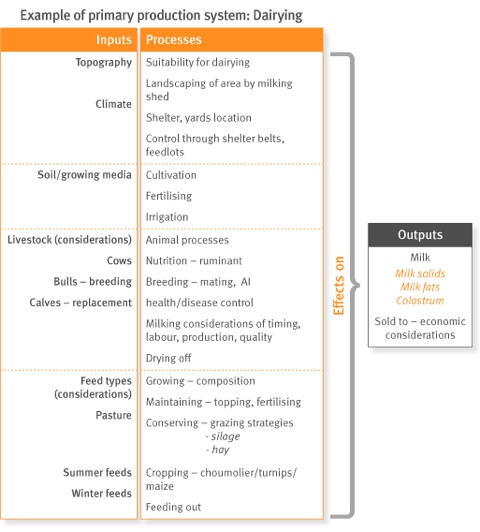Sample programme: Agricultural focus
High-level question
How can a dairy farmer produce milk of high quality and in quantity for the longest period of time?
Second-level questions
1. Why is dairying predominant in this region?
Introducing the learning context
Suggested time: 7–10 weeks
Resource requirements: Visit to dairy farm, soil investigations, and experiments
Consider:
- location: geography, transport, processing facilities, irrigation, and so on
- topography/distribution pattern (local and national)
- climate: sunshine hours, annual rainfall, extreme events, annual and daily temperature, and so on
- soils: properties (texture, structure), modification of properties (through use of fertilisers, drainage, irrigation, cultivation).
Possible achievement standards: AS90918, AS90157, AS90919, AS90920.
2. What management practices result in high-quality milk?
Developing aspects of primary production in the context of dairying
Suggested time: 12–15 weeks
Resource requirements: Visit to dairy farm, pasture investigations, and fertiliser experiments
Consider:
- management practices that increase the quality and quantity of milk production
- breed selection: breeding programme, specific attributes, timing, use of AI, genetics, reproductive physiology
- feed management: pasture growth (seed mix, weed control, fertiliser application, soil modification), maintenance, production, conservation (stocking rates, silage and haymaking, and so on); supplementary feed including feed selection (quantity, quality, timing); digestive physiology (ruminant compared to monogastric); nutritional diseases
- health and disease management: pest and disease control (including internal and external parasites); loss of production, withholding periods, use of drenches.
Possible achievement standards: AS90918, AS90157, AS90921, AS90155.
3. What is the impact on the environment of producing high volumes of high-quality milk?
Exploring the environmental impacts of dairying
Suggested time: 5–7 weeks
Resource requirements: visit to dairy farm, investigations, and experiments
Consider:
- effluent management: dairy shed practices; spreading of effluent, storage, treatment, and recycling; runoff; carrying capacity; water quality
- soil impacts: compaction, pugging, erosion, runoff; stock camping areas (sleeping, standing zones); stocking rates; over-cultivation; crop rotation; pasture management programmes
- nutrient impacts: fertiliser application rate, frequency, type; nutrient recycling through effluent spreading
- chemical impacts: weed control; gas emissions of ruminants (carbon credits?), biological control
- production impacts: noise; smell; faeces (return of nutrients to soil, mess on roadways, etc.); movement of stock; transport; wear and tear on roads; visual impact.
Possible achievement standards: AS90160, plus aspects of AS90918, AS90157, AS90919, AS90921, AS90155.
4. How will the production of high volumes of high-quality milk impact on returns to the dairy farmer?
Revising the concepts covered in the learning programme
Suggested time: 3–5 weeks
Resource requirements: Visit to dairy farm, results from investigations and experiments carried out throughout the year
Consider:
- production costs: compliance cost of new effluent management requirements – and penalty for any failure to meet these requirements
- labour availability: the need for skilled, reliable labour, the provision of housing, and so on
- management decisions: the suitability of practices used in the production process, based on economic considerations such as those relating to the environment; feed conservation techniques; time for drying off.
Learning could be partly assessed using achievement standards AS90157, AS90919, AS90920, (also business studies).
Note
When planning internal assessments, take into consideration how these fit into the wider school programme, and ensure that students have a balance of internal and external assessment.
Example of primary production system: Dairying

Dairying diagram
Last updated December 5, 2011
TOP


